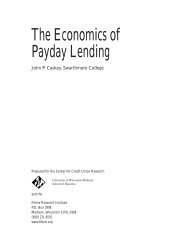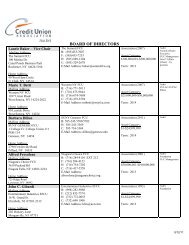CFPB Streamlining Regs Comment Letter - Credit Union Association ...
CFPB Streamlining Regs Comment Letter - Credit Union Association ...
CFPB Streamlining Regs Comment Letter - Credit Union Association ...
You also want an ePaper? Increase the reach of your titles
YUMPU automatically turns print PDFs into web optimized ePapers that Google loves.
Reforming Regulation Z<br />
There is no regulation that epitomizes the need for regulatory streamlining more than Regulation<br />
Z, which implements the Truth in Lending Act. The Truth in Lending Act is based on the simple<br />
and laudable proposition that consumers should be able to easily compare the terms of credit.<br />
While its purpose can be reduced to a simple sentence, its application has spawned thousands of<br />
pages of mind-numbing legalese that must be translated into equally confusing consumer<br />
disclosures which, far from helping the consumer compare credit terms, all too often frustrate<br />
and confuse them. These disclosures do, however, provide the basis for lawsuits which also do<br />
little to better inform the consumer about the terms of credit she is receiving. In an ideal world,<br />
Congress and regulators would start from scratch by keeping the statute in place but none of its<br />
regulations. Recognizing that this is not realistic, there are several steps that the <strong>CFPB</strong> could<br />
take to aid financial institutions to more clearly implement these regulations.<br />
Regulation Z should be grouped not by open-end and closed-end credit, but by the most common<br />
products it regulates. The goal would be to make compliance easier by eliminating the need for<br />
cross-referencing regulations and applying terms in different contexts. For example, 12 CFR<br />
1026.5 dealing with form of disclosures provides as follows:<br />
(A) The following disclosures need not be written: Disclosures under §1026.6(b)(3) of charges that are imposed as<br />
part of an open-end (not home-secured) plan that are not required to be disclosed under §1026.6(b)(2) and related<br />
disclosures of charges under §1026.9(c)(2)(iii)(B); disclosures under §1026.9(c)(2)(vi); disclosures under<br />
§1026.9(d) when a finance charge is imposed at the time of the transaction; and disclosures under §1026.56(b)(1)(i).<br />
There are no fewer than seven cross-references, each of which exempts specific products, and<br />
this is the section dealing with general disclosure requirements for open-end-loans. The<br />
problem is that many of the most commonly used financial products today were not in existence<br />
or wide use when these regulations were originally promulgated. As new products came into<br />
existence, they were simply grafted onto the existing regulations. For example, much of the<br />
preceding paragraph could be eliminated if all of the relevant regulations dealing with unsecured<br />
open-end lines of credit were placed in one section and all of the required regulations for<br />
complying with home equity lines of credit were placed in another.<br />
Similarly, as regulators attempt to impose additional notice requirements on subprime loans, the<br />
traditional notion of a closed-end loan does little to aid a practitioner trying to comply with<br />
regulations and provide adequate notices to consumers. For example definitions for a HOEPA<br />
loan (1026.32) provide the following set of definitions:<br />
Definitions. For purposes of this subpart, the following definitions apply:<br />
(1) For purposes of paragraph (a) (1) (ii) of this section, points and fees means:<br />
(i) All items required to be disclosed under §1026.4(a) and 1026.4(b), except interest or<br />
the time-price differential;






